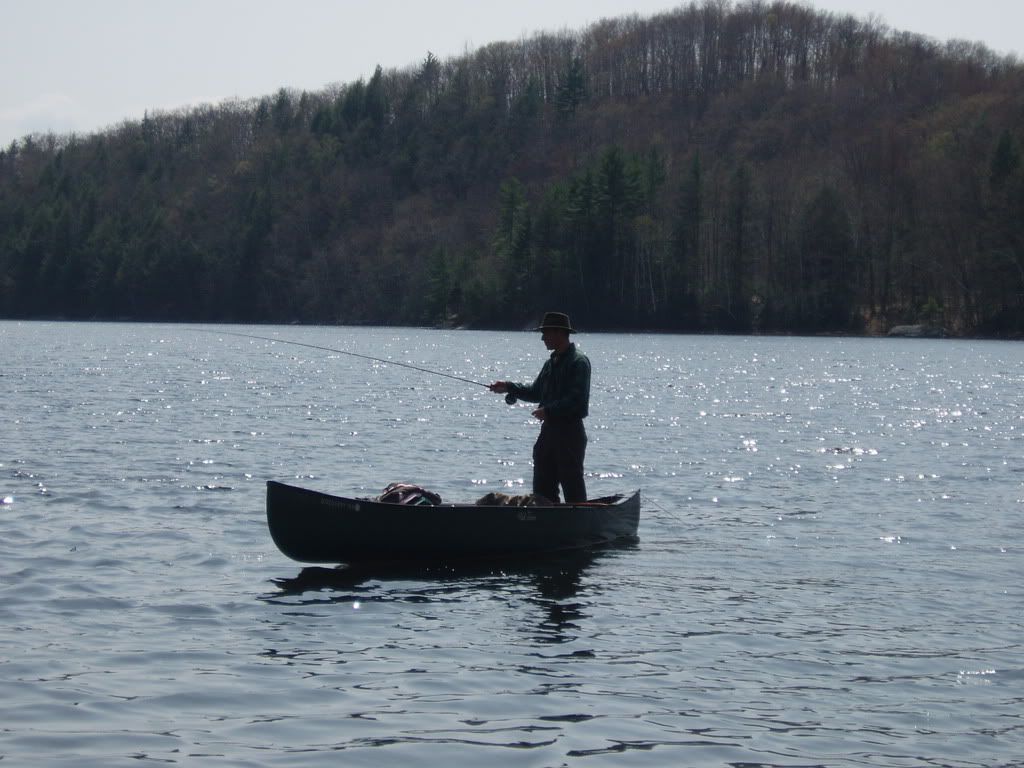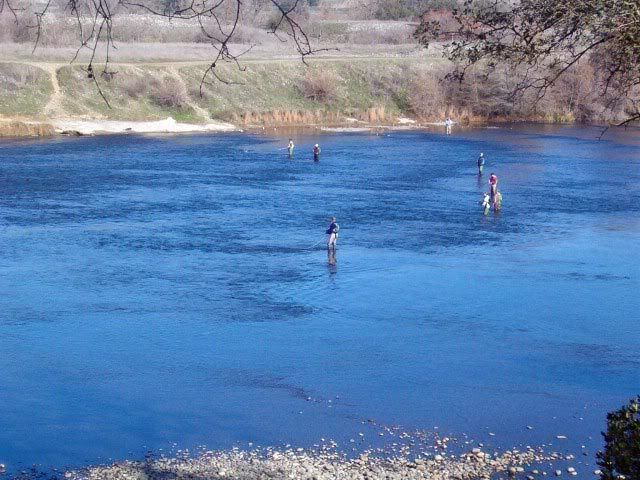Fishing for Trout in a small creek or stream differs a lot from days out on a lake or larger river. Most differences come in the form of size and textures of your flies, but there are some details that are overlooked. Here are the top four overlooked strategies when it comes to fly fishing the smaller tributaries.
Don't pre-judge size
Often times people tend to think the smaller the river the smaller the bait. This is not necessarily true. Last year, on a fishing trip with one of my friends who is an outstanding dry fly fisher, I was reminded of this valuable lesson. On this trip we were to be fishing a tributary to one of my favorite rivers. I thought that this would be an average fishing day, with no particularly large trout, but that soon changed when he brought out a twenty one inch cut-throat in the first few casts, and numerous good sized fish after that. After hours of me fishing with my ordinary tackle and coming up empty handed, I asked him what he was using. He showed me a size ten salmon fly. I thought this was ridiculous for that size of creek, but I tried the behemoth fly and on the fourth cast landed a twenty inch brown trout. This will remain a lesson I will never again forget.
Keep an eye on the choppy
Another lesson I learned from this outing is to never overlook the choppier waters on these smaller bodies. On a lager river the choppy waters usually mean the fish will have to struggle to keep their energy levels up, while feeding, for two reasons. The first is that there is less food in the faster moving water, and it is harder to catch the food because of the faster moving currents. The second is because the choppy waters on a lager river or creek has more volume moving through, therefore the water is moving faster than it looks or with more force than in a smaller stream or creek. However, on smaller stream there is usually more food due to the conditions surrounding these streams. Often these smaller water bodies contain a lot more competition in the pooled areas due to the smaller volume and better feeding grounds. This can result in some trout having to venture into the choppier waters to find food. For the best results on these swifter currents try to use the areas with minute back eddies, small breaks, and traceable rock obstructions. These areas can produce a lot of fish while you are moving between pools, and sometimes can even produce a twenty inch hog as well.
Match the hatch, or not!
Most Times I see people try to match food in the stream too much. I am Not going to tell you that this is a bad idea, but if it is not working try throwing out something that is practical of the area you are fishing, but maybe not there during that particular time. Sometimes fish will hold up on feeding in order to save their energy for a hatch or evening gathering they are anticipating. They may also be holding out for a more nutritious meal. If the fish are not biting on the usual flies that your seeing try a dun pattern, a wolf pattern, a hopper, a stone fly nymph, maybe a muddler minnow, or any other form of food that you have seen in that area before. Just keep in mind that these flies stated earlier might not work in all streams.
Be different
In small streams people often shy away from terrestrial of flashy flies like a muddler minnow, beetle, ant, or hopper pattern. These flies can be great for bringing out some of those larger, smarter fish. Last spring I had a once in a lifetime encounter with an obscure, yet fun fishing experience. Fishing in a stream no wider than my eight foot fly rod I brought out three browns that were over twenty inches, and managed to fish for half an hour with a brown that was around seven or eight pounds, which is a hog by any standards for a stream that small, however with my four pound tippet and the current working against me he managed to escape. All of these fish were brought in, or at least hooked, by a size fourteen muddler minnow. Before that Trip the thought had never crossed my mind to use such a flashy fly in my fishing arsenal, and after that day it is now the number one thing I do when the fish just will not bite.
Since the age of eight I have enjoyed fishing the small streams and tributaries. There is something about these little known secrets in the fishing world that can bring a great day to your fishing season. Another thing that can bring a better season is to take someone fishing with you, weather it be your wife, girlfriend, kids, a friend, or a neighbor across the street, bring then fishing and I hope you all have a wonderful time. I hope these tips were helpful and have a great fishing trip.
Don't pre-judge size
Often times people tend to think the smaller the river the smaller the bait. This is not necessarily true. Last year, on a fishing trip with one of my friends who is an outstanding dry fly fisher, I was reminded of this valuable lesson. On this trip we were to be fishing a tributary to one of my favorite rivers. I thought that this would be an average fishing day, with no particularly large trout, but that soon changed when he brought out a twenty one inch cut-throat in the first few casts, and numerous good sized fish after that. After hours of me fishing with my ordinary tackle and coming up empty handed, I asked him what he was using. He showed me a size ten salmon fly. I thought this was ridiculous for that size of creek, but I tried the behemoth fly and on the fourth cast landed a twenty inch brown trout. This will remain a lesson I will never again forget.
Keep an eye on the choppy
Another lesson I learned from this outing is to never overlook the choppier waters on these smaller bodies. On a lager river the choppy waters usually mean the fish will have to struggle to keep their energy levels up, while feeding, for two reasons. The first is that there is less food in the faster moving water, and it is harder to catch the food because of the faster moving currents. The second is because the choppy waters on a lager river or creek has more volume moving through, therefore the water is moving faster than it looks or with more force than in a smaller stream or creek. However, on smaller stream there is usually more food due to the conditions surrounding these streams. Often these smaller water bodies contain a lot more competition in the pooled areas due to the smaller volume and better feeding grounds. This can result in some trout having to venture into the choppier waters to find food. For the best results on these swifter currents try to use the areas with minute back eddies, small breaks, and traceable rock obstructions. These areas can produce a lot of fish while you are moving between pools, and sometimes can even produce a twenty inch hog as well.
Match the hatch, or not!
Most Times I see people try to match food in the stream too much. I am Not going to tell you that this is a bad idea, but if it is not working try throwing out something that is practical of the area you are fishing, but maybe not there during that particular time. Sometimes fish will hold up on feeding in order to save their energy for a hatch or evening gathering they are anticipating. They may also be holding out for a more nutritious meal. If the fish are not biting on the usual flies that your seeing try a dun pattern, a wolf pattern, a hopper, a stone fly nymph, maybe a muddler minnow, or any other form of food that you have seen in that area before. Just keep in mind that these flies stated earlier might not work in all streams.
Be different
In small streams people often shy away from terrestrial of flashy flies like a muddler minnow, beetle, ant, or hopper pattern. These flies can be great for bringing out some of those larger, smarter fish. Last spring I had a once in a lifetime encounter with an obscure, yet fun fishing experience. Fishing in a stream no wider than my eight foot fly rod I brought out three browns that were over twenty inches, and managed to fish for half an hour with a brown that was around seven or eight pounds, which is a hog by any standards for a stream that small, however with my four pound tippet and the current working against me he managed to escape. All of these fish were brought in, or at least hooked, by a size fourteen muddler minnow. Before that Trip the thought had never crossed my mind to use such a flashy fly in my fishing arsenal, and after that day it is now the number one thing I do when the fish just will not bite.
Since the age of eight I have enjoyed fishing the small streams and tributaries. There is something about these little known secrets in the fishing world that can bring a great day to your fishing season. Another thing that can bring a better season is to take someone fishing with you, weather it be your wife, girlfriend, kids, a friend, or a neighbor across the street, bring then fishing and I hope you all have a wonderful time. I hope these tips were helpful and have a great fishing trip.
If you like this article, check out my blog: http://flyfishingstrategy.blogspot.com/ for more tips on fishing and fly fishing for trout as well as bass and Pike.
Article Source: http://EzineArticles.com/?expert=Jason_Shaw
See my previous post:Fly Fishing Tips and Techniques
See my previous post:Fly Fishing Tips and Techniques




